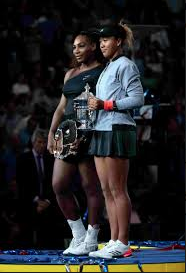U.S. Open Women’s Finals controversy explained
4 min read
USA Today
By ADDIE HINTON
Staff Writer
The world saw another scandal unfold at the U.S. Open in Flushing Meadows, New York, as Serena Williams entered center stage once more for this year’s finals match against Naomi Osaka.
Williams, and many others it seems, attribute her outbreak to be less about unfair callings and rulings, but one about sexism.
“There are a lot of men out here who have said a lot of things but because they’re men that doesn’t happen,” said Williams to the tournament director after being penalized a full game.
“You’re gonna take this away from me because I’m a woman?” said Williams.
This led people to question whether this incident was because of a sexist system in place at the U.S. Open, or if Serena was simply throwing an unwarranted temper tantrum and using sexism as a crutch.
Billie Jean King, a retired tennis legend, believes that sexism is exactly what Serena experienced that Saturday. She tweeted after the event, “When a woman is emotional, she’s ‘hysterical’ and she’s penalized for it. When a man does the same, he’s ‘outspoken’ and there are no repercussions. Thank you, @serenawilliams, for calling out this double standard. More voices are needed to do the same.”
While King believes sexism is still alive and well in the tennis community, many lost sympathy for Serena after she began yelling at Carlos Ramos, the chair umpire. She demanded an apology and called him a thief after her third conduct code violation.
Throughout the course of the match, Williams received three conduct code violations. The first was from receiving coaching, the second was for breaking her tennis racquet, and the third was for verbal abuse against Ramos.
“I don’t cheat to win, I’d rather lose,” said Williams to Ramos following the first violation.
Once Ramos charged her with racquet abuse and penalized her one-point Williams demanded an apology, claiming that she has never cheated in her life. Their conversation escalated, and Williams eventually called him a thief. Immediately after she was penalized a full game for verbal abuse, putting her down 5-3 in the second set.
“Well, I mean, I’m honest, I was coaching,” said Williams’ coach, Patrick Mouratoglou, in an interview with ESPN.

Despite admitting to breaking the rules, he claims that Williams did not notice him and had no idea he was coaching. While coaching and racquet abuse are prohibited in tennis matches, Mouratoglou says that everyone does it and that it is an unusual instance for any player in a Grand Slam final to be given a warning about it. Once Williams was penalized a point even the announcers can be heard saying that a point penalty in this situation is extremely rare.
Williams is not unfamiliar with causing controversy at the U.S. Open. In 2009 she was penalized for crossing the plain of the court before making contact with the ball on her serve, also known as a foot fault, which later was determined to be a wrong call. In 2011 she was penalized for shouting in the middle of a point. Because of this, she does not have the best reputation for maintaining composure on the court. For people like Mark Knight, an artist for the Herald Sun in Australia, this reputation served as a sort of inspiration for his next caricature.
Many found Knight’s picture of Williams to be racist and insulting, but the people at the Herald Sun had a different opinion. In an article from the Washington Post, Michael Miller, the executive chairman of News Corp. Australia stated in response to the backlash, “Shows that the world has gone too PC (politically correct) and misunderstand the role of news media cartoons and satire. Poor behavior in any sport needs to be called out.”
In the comic Williams is depicted with frizzy hair, big lips, a big nose, and a large figure. Many viewers were quick to point out this resemblance to Jim Crow imagery. While caricatures are supposed to magnify a person’s features, it’s not meant to magnify, “features that stand out when compared to white people”, as Darrin Bell an RFK Award-winning cartoonist states. Instead, he says that he would have focused on Williams’s, “eyebrows, and her outfit, as well as her cheekbones, which, together with her strong chin and jawline, give her a diamond-shaped head.” His caricature shows Williams as strong and depicts her breaking the “racquet of sexism.”
At the end of the match, after Osaka had defeated one of her favorite tennis icons and won her first major title, the crowd started booing. It was obvious who everyone had been rooting for. With the composure of an experienced champion Williams is seen embracing Osaka during the award ceremony and telling everyone to stop booing and to instead congratulate Osaka. While many may look back at this match and only think of Williams, they must not forget that Osaka too made history on that court by becoming the first person from Japan to ever win a Grand Slam Tournament.


